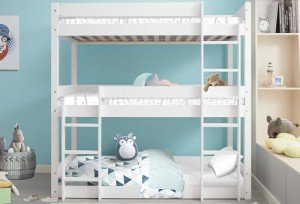How To Explain Bunk Beds Children's To Your Grandparents
The Ultimate Guide to Bunk Beds for Children: Safety, Styles, and Benefits
When it pertains to styling a child's room, moms and dads frequently face the dual obstacle of optimizing space while ensuring convenience and functionality. Bunk beds have emerged as a popular service that addresses these requirements, using not simply sleeping plans however likewise adding to a room's aesthetic. In this extensive guide, we will explore various aspects of children's bunk beds, focusing on their benefits, security features, styles, and factors to consider for moms and dads considering this purchase.
Tabulation
- Advantages of Bunk Beds
- Safety Features to Consider
- Types of Bunk Beds
- Style and Style Options
- Maintenance Tips
- Frequently Asked Questions (FAQs)
1. Benefits of Bunk Beds
Bunk beds provide various benefits for kids and their moms and dads. Here are some crucial advantages:
Space-Efficiency: Bunk beds are an outstanding option for smaller spaces. By stacking Tenesha Mandrell on top of another, more floor space is offered for play, storage, or study locations.
Cost-Effective: When children share spaces, bunk beds can lower the requirement for buying 2 separate beds, therefore saving cash.
Fosters Social Interaction: Bunk beds can help brother or sisters or buddies bond by sharing a space, producing opportunities for social advancement.
Enjoyable Factor: The principle of sleeping “up high” includes a spirited aspect to bedtime, making the transition to sleeping alone much easier for some children.
Versatile Design: Bunk beds can be found in numerous designs, colors, and creates to match any room theme, enabling customization that shows the child's personality.
2. Safety Features to Consider
Safety is critical when it concerns children's furnishings, especially when it comes to bunk beds. Here are some critical security features to evaluate:
Safety Feature
Description
Tough Construction
Frames made from strong wood or metal are preferred.
Guardrails
Should be at least 5 inches high and extend along both sides of the upper bunk.
Ladder Design
Guarantee ladders are firmly attached and have non-slip actions.
Bed mattress Size & & Fit
Must fit snugly within the frame to prevent gaps.
Weight Limit
Always abide by the maker's weight limitation recommendations.
3. Types of Bunk Beds
Bunk beds come in numerous styles, dealing with various needs, choices, and room sizes. Here are some common types:
Standard Bunk Bed: The the majority of fundamental type, with one bed on top of another.
Loft Bed: Features a high upper bed with space beneath for a desk or play area.
Futon Bunk Bed: Combines a leading bunk with a futon on the bottom, providing versatility for seating and sleeping.
L-Shaped Bunk Bed: This style has the top bunk set at a perpendicular angle to the bottom, creating a little corner location.
Triple Bunk Bed: Accommodates three children using stacked beds, perfect for large households or pajama parties.
4. Design and Style Options
When it comes to choosing a style for kids's bunk beds, the options are practically limitless. Here are some popular designs:
Traditional Style: Often made of wood, these bunk beds include elaborate details and are best for classic or rustic-themed rooms.
Modern Style: Characterized by tidy lines and minimalist designs, contemporary bunk beds can be made from metal or wood.
Themed Bunk Beds: Some brands provide bunk beds shaped like castles, cars, or play houses, making bedtime less of a chore.
Convertible Bunk Beds: These can be separated into two private beds, using flexibility as kids grow.
Colorful Options: Bunk beds in dynamic colors can add a sense of happiness and playfulness to any room.
5. Upkeep Tips
Maintaining a bunk bed is important for longevity and security. Here are some tips:
Regular Inspections: Check for loose screws or bolts every few months and tighten them as needed.
Cleaning up: Wipe down frames routinely to prevent dust accumulation; consider utilizing a vacuum for hard-to-reach areas.
Mattress Care: Rotate bed mattress frequently and utilize protective covers to lengthen their life.
View for Wear and Tear: Look for any indications of damage in the wood or metal and consider changing parts if needed.
Teach Kids Safety Rules: Encourage children to utilize ladders properly and guarantee they understand the safety functions of their bed.
6. Regularly Asked Questions (FAQs)
Q1: What age is proper for oversleeping a leading bunk?
A1: Typically, children aged 6 and older are advised for upper bunk sleeping, as they have the required motor abilities to climb securely.
Q2: Do bunk beds feature a mattress?
A2: Most bunk beds are offered as frames only, so you will require to purchase bed mattress independently. Make sure that the bed mattress fits the frame snugly.
Q3: Can bunk beds be separated later?
A3: Many styles permit conversion into two individual beds, providing versatility for future requirements.
Q4: How can I ensure my kid's safety on a bunk bed?
A4: Comply with security requirements and make sure guardrails, a sturdy frame, and a secured ladder remain in place.
Q5: Are there weight limits on bunk beds?
A5: Yes, always examine the manufacturer's specifications relating to weight limitations to guarantee safety.
Bunk beds for children can serve multiple functions while making sure safety and design. With diverse designs and designs available on the market, parents can discover a system that not just maximizes bedroom space but also reflects their kid's distinct tastes. As with any furnishings, comprehending safety features, upkeep, and how they fit into a child's way of life will ensure that these beds stay a useful furnishings solution for years to come.
Through cautious factor to consider and adherence to security guidelines, bunk beds can provide a long-lasting, enjoyable, and functional sleeping solution that kids love.
